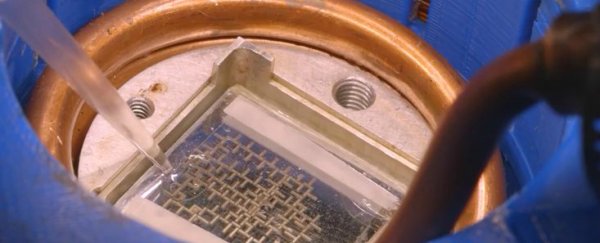Researchers in the US have built a fully functioning computer that runs like clockwork - but instead of electrons, it operates using the movement of tiny magnetised water droplets. The ultimate goal is to use the machine to precisely control and manipulate matter, the same way that regular computers manipulate information.
Although this new water-based computer could theoretically do everything a normal computer can thanks to its universal logic gates, it's much slower than the devices we currently use. But the team has far bigger plans in mind for their invention - revolutionising the way we process and manufacture materials.
"We already have digital computers to process information … Our goal is to build a completely new class of computers that can precisely control and manipulate physical matter," Manu Prakash, lead researcher and bioengineer at Stanford University, said in a press release. "Imagine if when you run a set of computations that not only information is processed but physical matter is algorithmically manipulated as well. We have just made this possible at the mesoscale [10 microns to 1 millimetre]."
"In this work, we finally demonstrate a synchronous, universal droplet logic and control," he added.
Prakash first came up with the idea for the computer nearly a decade ago, but although it was easy enough to work out how to control water droplets - by infusing them with magnetic nanoparticles and moving them around a maze of iron bars - finding a way to synchronise these movements proved challenging.
In regular computers, this is the role of the clock, which perfectly times every single movement within the system, but Prakash's team struggled to find something that would do the same thing with water. But then they came up with the idea of a rotating magnetic field.
"Every time the field flips, the polarity of the bars reverses, drawing the magnetised droplets in a new, predetermined direction, like slot cars on a track," the Stanford press release explains. "Every rotation of the field counts as one clock cycle, like a second hand making a full circle on a clock face, and every drop marches exactly one step forward with each cycle."
You can see the system in action below:
Prakash's team found that this magnetic 'clock' moves the system forward in perfect synchrony, which means that it can run virtually forever without errors. And it carries information using the absence or presence of water droplets as the 1s and 0s of its binary code.
"Following these rules, we've demonstrated that we can make all the universal logic gates used in electronics, simply by changing the layout of the bars on the chip," said co-researcher Georgios Katsikis. "The actual design space in our platform is incredibly rich. Give us any Boolean logic circuit in the world, and we can build it with these little magnetic droplets moving around."
Publishing in the journal Nature Physics, the team also demonstrated that they could use the system to build a simple-state machine that included 1-bit memory storage.
The current chips are about half the size of a postage stamp, and the droplets are smaller than poppy seeds, but the team see no reason they can't keep making the system smaller, as well as adding more drops to make it more complex.
They're hoping this will allow them to perform reactions that are currently done in bulk in test tubes with their computer - essentially, each droplet can carry chemicals within it and can become its own perfectly controlled test tube.
The team is now creating a design tool that lets anyone build their basic system and play around with the design to help take it to the next level. "We are trying to bring the same kind of exponential scale up because of computation we saw in the digital world into the physical world," said Prakash.
